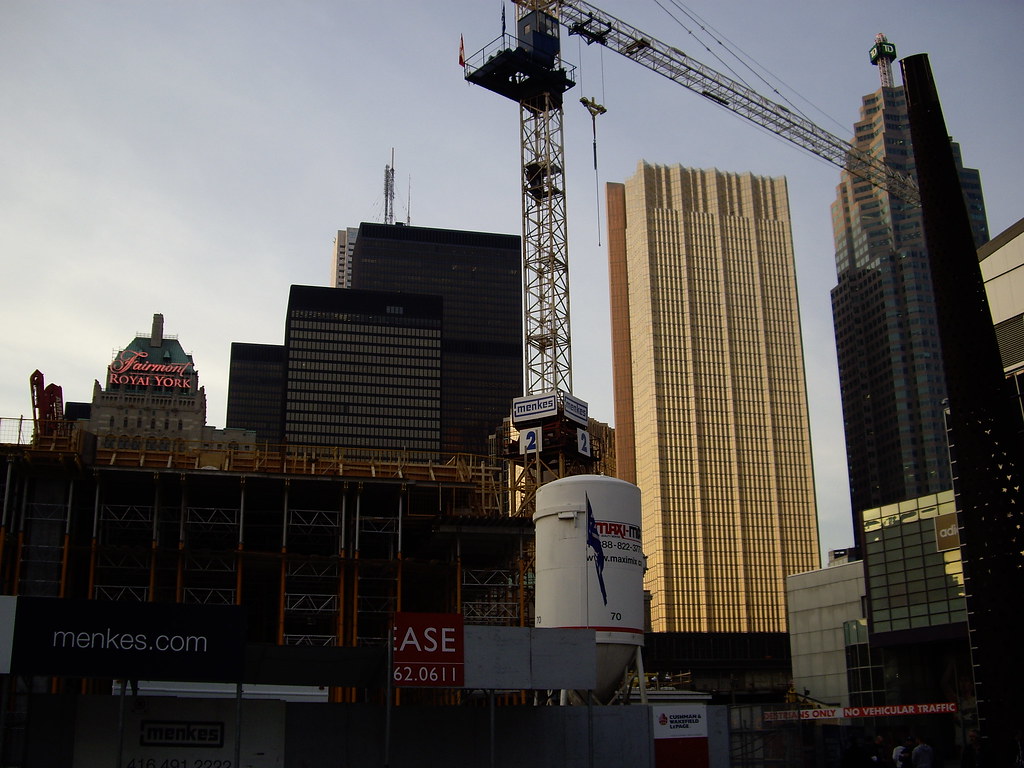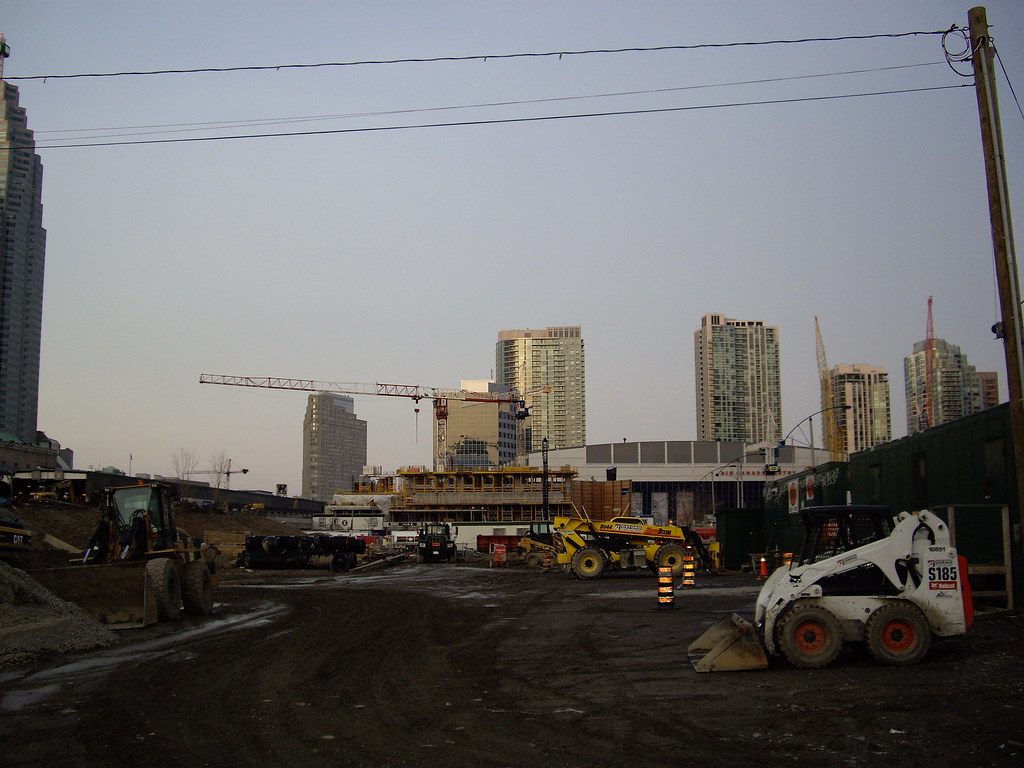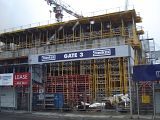yyzer
Senior Member
interesting article in Daily Commercial News - they are pumping concrete to the site through pipes underneath York St....
Buried pipes deliver concrete to Menkes office-tower site
DAN O’REILLY
correspondent
Not only is it the first major office building to be constructed in downtown Toronto in more than a decade, the $250-million 30-storey 25 York Street project by developer/builder Menkes can be considered a prototype for innovative, smooth and fast-operating concrete pumping.
That’s because there are never any ready-mix trucks lined up on the adjacent street or cluttering up the building site.
Instead, a 700-horsepower high-pressure concrete pump sits in a parking lot across the road from the site, pumping the concrete through pipes under the road to a 110-foot-radius placing boom on the building site. This set-up ensures that crane time is freed up for other trades.
“We’ve maybe increased production by 30 per cent...†says John Neilson, senior superintendent, Menkes Construction, in assessing the success of the operation.
Approximately 55,000 cubic metres of concrete will have been poured by the time the building has been substantially completed by July 2009, he says.
Neilson credits that success to concrete pump contractor Amherst Group and, in particular to pump manager Paul Turney.
Hemmed in by the Air Canada Centre on the east, a railway line immediately to the north and by busy York Street, the logistics of the tight building site “demanded that we do something different,†says Turney.
On the west side of York Street is a parking lot used as the staging area for the pump operation.
“It’s absolutely doable,†he recalls telling forming contractor Premform Limited and Menkes officials when he originally made the proposal. The developer quickly bought into the idea and was able to arrange the use of parking lot with the co-operation of the owners.
Obtaining approvals from city officials, however, to bury pipes under the street took some time. Finally those approvals were given and then one Saturday last summer, three pipes were installed under York Street by site services contractor VIPE while still keeping the road partially opened, says Turney.
Concrete is pumped through one main line, while the second line serves as a backup and the third is a spare, says Turney.
Amherst spent $800,000 purchasing the German-manufactured pump and place boom, and the peripheral equipment that runs pipelines specifically for this project, but actually used it first on the 10.4-kilometre-long 14.4 metre-diameter concrete lined tunnel constructed at the Sir Adam Beck Generating Complex in Queenston.
While an expensive investment, the efficient fast-operating system requires just one person on the pump and a second to manoeuvre the on-site boom. Only about five to six minutes are required for a truck to unload the concrete into the pump. Some support labour is required when it comes time to raise the boom to another floor, he says.
“We have a real production line going here,†says Turney, who believes the operation is saving the developer time and money. Approximately 200 to 300 metres of concrete can be poured during an eight-hour working day.
Buried pipes deliver concrete to Menkes office-tower site
DAN O’REILLY
correspondent
Not only is it the first major office building to be constructed in downtown Toronto in more than a decade, the $250-million 30-storey 25 York Street project by developer/builder Menkes can be considered a prototype for innovative, smooth and fast-operating concrete pumping.
That’s because there are never any ready-mix trucks lined up on the adjacent street or cluttering up the building site.
Instead, a 700-horsepower high-pressure concrete pump sits in a parking lot across the road from the site, pumping the concrete through pipes under the road to a 110-foot-radius placing boom on the building site. This set-up ensures that crane time is freed up for other trades.
“We’ve maybe increased production by 30 per cent...†says John Neilson, senior superintendent, Menkes Construction, in assessing the success of the operation.
Approximately 55,000 cubic metres of concrete will have been poured by the time the building has been substantially completed by July 2009, he says.
Neilson credits that success to concrete pump contractor Amherst Group and, in particular to pump manager Paul Turney.
Hemmed in by the Air Canada Centre on the east, a railway line immediately to the north and by busy York Street, the logistics of the tight building site “demanded that we do something different,†says Turney.
On the west side of York Street is a parking lot used as the staging area for the pump operation.
“It’s absolutely doable,†he recalls telling forming contractor Premform Limited and Menkes officials when he originally made the proposal. The developer quickly bought into the idea and was able to arrange the use of parking lot with the co-operation of the owners.
Obtaining approvals from city officials, however, to bury pipes under the street took some time. Finally those approvals were given and then one Saturday last summer, three pipes were installed under York Street by site services contractor VIPE while still keeping the road partially opened, says Turney.
Concrete is pumped through one main line, while the second line serves as a backup and the third is a spare, says Turney.
Amherst spent $800,000 purchasing the German-manufactured pump and place boom, and the peripheral equipment that runs pipelines specifically for this project, but actually used it first on the 10.4-kilometre-long 14.4 metre-diameter concrete lined tunnel constructed at the Sir Adam Beck Generating Complex in Queenston.
While an expensive investment, the efficient fast-operating system requires just one person on the pump and a second to manoeuvre the on-site boom. Only about five to six minutes are required for a truck to unload the concrete into the pump. Some support labour is required when it comes time to raise the boom to another floor, he says.
“We have a real production line going here,†says Turney, who believes the operation is saving the developer time and money. Approximately 200 to 300 metres of concrete can be poured during an eight-hour working day.




